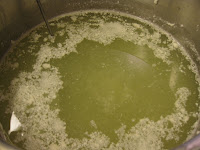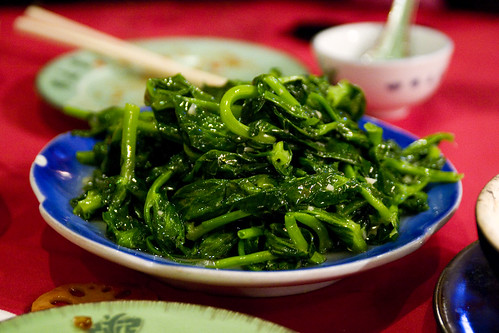Cheesemaking might be the most infuriating food project I’ve ever undertaken. I thought it would be so pastoral, even poetic to find farm fresh milk, apply a little know how and make a product that was arguably 1000% better than its parts. What a crock. It turned out to be a hair puller – like the nervous, pissed off pull-out-your-eyebrow-hairs-with-your-fingernails psychotic kind of irritated. The box (“Home cheese making” by Ricki Carroll) proclaimed five year old children could be parma prodigy and anyone could make cheese the first time and every time like a pro. This is in fact a damn dirty lie.
I consider myself a decent cook. I like to cook and do it often. Some dishes come out far better than others and I will reflect this variance in the “my grade” report on every recipe (based on my opinion and diners’ opinions). I don’t know why the hell I’m making myself worry about yet another GPA-esque number, but I guess I’m a glutton (for pun-ishment ahahaha, no.). The first time I tried my hand at this recipe, the curds didn’t properly form and I was left with murky green Bayoubend like whey and barf like strands of curd. YUM!
 No whey.
No whey.
 I think this picture was supposed to make Houston look good.
I think this picture was supposed to make Houston look good.
The second attempt almost got there. The curds formed and I got to the stretching phase of the process. Then everything disintegrated into an overheated mass of grainy goo. This was salvaged in a strainer and became a sort of ricotta cheese. Tasty, but not mozzarella. Still, the show had to go on and I used it on my pizza dough. (recipe follows)
 Caramelized Onion, Prosciutto, oven roasted tomatoes in garlic, mozz/ricotta disaster, fresh basil
Caramelized Onion, Prosciutto, oven roasted tomatoes in garlic, mozz/ricotta disaster, fresh basil
The next day true frustration set in and I found another recipe online. Unwittingly thinking this was a totally different recipe, I went ahead with it. Later I discovered it was developed by the same folks that provided my two prior fails. This recipe makes a harder/firmer cheese. The prior recipe supposedly makes a softer, more pillowy cheese, but I wouldn’t know from personal inspection. This cheese was indeed rather hard as far as fresh mozz goes, but retained the gooey soft melting texture so sought after.
EZ Cheese
* 1/2 rennet tablet
* 1/4 cup cool, chlorine-free water (most bottled waters are chlorine-free)
* 1 gallon milk (2%, 1%, or skim)
* 2 teaspoons citric acid
* Salt, optional
Preparation:
Crush the rennet into the water and stir to dissolve. Pour milk into a non-reactive pot (no aluminum or cast iron). Place over medium heat. Sprinkle the citric acid over the milk and stir a few times. Heat milk to 88 degrees F. Milk will begin to curdle.
At 88 degrees F, add the rennet solution and continue stirring slowly every few minutes until the milk reaches 105 degrees F. Turn off the heat. Large curds will appear and begin to separate from the whey (the clear, greenish liquid).
With a slotted spoon or mesh strainer, scoop the curd into a large glass bowl. (If it's still too liquid, let it set for a few more minutes). Press the curds gently with your hand and pour off as much whey as possible. Microwave curds on high for 1 minute, then drain off all the excess whey. With a spoon, press curds into a ball until cool. Microwave two more times for 35 seconds each, and continue to drain the whey and work cheese into a ball. In the meantime, place the whey over medium heat and let it heat to about 175 degrees F.
When cheese is cool enough to touch, knead it like bread dough until smooth. When you can stretch it like taffy, it is done. You can sprinkle 1 to 2 teaspoons salt into the cheese while kneading and stretching it. The cheese will become stretchy, smooth and shiny. If it is difficult to stretch and breaks easily, dip it into the hot whey for a few seconds to make it warm and pliable. Then pick it up again and stretch it into a long rope. Fold over and stretch again. Dip in hot whey as needed to make the cheese pliable.
When the cheese is smooth and shiny (this takes just a few minutes), it is ready to eat. Shape it, then store in a solution of 2 teaspoons salt to 1 cup water.
Shapes:
To form the traditional ball shape: Fold the cheese into itself, tucking the loose ends into the bottom. This will create a smooth and tight surface to work from. Section a desired piece/size from the smooth mass and pinch it off by squeezing your fingers together around the base. Ta Da!




To fill with things: Roll the cheese out like a piece of dough to desired thickness in a vague rectangular shape. Fill with sundried tomatoes, caramelized onions, prosciutto and fresh basil (shown), fresh thyme, jalapenos, anything your heart desires. Roll, slice and eat.

 H8 U Cheese
H8 U Cheese
Yield: ¾ pound Mozzarella Cheese
1 Gallon milk (not ultra pasteurized)
1¼ c cool water (chlorine-free, if you want to be sure it’s chlorine-free, use distilled water)
1½ t citric acid
¼ rennet tablet (¼ tsp. if using liquid)
1 t cheese salt
1. Dissolve ¼ rennet tablet into ¼ c of cool water. Stir and set aside. Wrap the remaining pieces of tablet in plastic wrap and store in the freezer
2. Mix 1½ t citric acid into 1 c cool water until dissolved.
3. Pour 1 gallon of milk into your pot and stir vigorously while adding the citric acid solution
4. Heat the milk to 90°F while stirring
5. Remove the pot from the burner and slowly stir in the rennet solution with an up and down motion for approximately 30 seconds
6. Cover the pot and leave it undisturbed for 5 minutes.
7. Check the curd. It should look like a custard, with a clear separation between the curd and whey. If it is too soft or the whey is milky, let set for a few more minutes. The curds never set up hard for me, but did come together in step 9.
8. Cut the curd with a knife that reaches to the bottom of your pot. Try to make little 1”x1” squares if your curd is firm enough.
9. Place the pot back on the stove and heat to 110° while slowly moving the curds around with your spoon.
10. Take off the burner and continue slowly stirring for 2-5 minutes depending on how firm you want your cheese.
11. Pour off the floating whey.
12. (waterbath method) Heat a pot of water to 185°F.
13. Ladle your curds into a colander, folding the curds gently as you drain off the whey. Dip the curds in the colander in the colander into the hot water. After several times take a spoon and fold the curds until they start to become elastic and stretchable. DO NOT let the cheese exceed 135° or you will be left with something like this:

Instead of something like this:

I would recommend using a thermometer in the whey and in the cheese, just to make sure you aren’t overheating either.
14. When it is stretchable remove the curd from the liquid and pull like taffy. This stretching elongates the proteins. If it does not stretch easily, return it to the hot water for more heat.
15. Add some salt to the cheese and work it in. Stretch until smooth and shiny.
16. Form into different shapes and store in ice water immediately and leave for 10 minutes
Three attempts at 2 different recipes and 3 gallons of organic milk later, I was left with a hardened mass of mildly delicious mozz. Someday I will break out the rennet and citric acid once more, but I have to let my eyebrows grow back first.
Recipe grade: D
My grade: C+ for effort
Diagnosis: LAME.
 My Favorite Thin Crust Pizza Dough Recipe
My Favorite Thin Crust Pizza Dough Recipe
(I stole this recipe from a blog awhile back and don’t remember which, opps. Props to you, whoever you are)
makes 2 pizzas, 12 inches each
about 400grams of flour, just shy of 2 cups, Plus more for kneading
1 package of dry active yeast (7 grams)
1 teaspoon of sugar
1 teaspoon of kosher salt
1 tablespoon of olive oil
200ml (7 oz) of warm water.
Whisk all dry ingredients in a large bowl. Add the olive oil and the warm water and bring it together with a wooden spoon or spatula.
Transfer dough to the bowl of a stand mixer with the dough hook attached and knead for about 4-5 minutes on low speed. Dough will still be quite wet when done, but it will look smooth. The dough must be moist before baked to be soft and moist after baking. Dry dough = dry crust = yuck. Transfer dough to a lightly oiled clean bowl and cover it with a kitchen towel. Let it rest for about 1 hour in a dry, warm spot.

Preheat oven to 475 degrees with the pizza stone placed in the middle rack.
Punch down dough with your fist (flour your hands first). Transfer dough to a well floured surface and knead lightly, adding flour as necessary just until it comes together in a ball.
Cut dough in half, wrap excess dough if not using it right away and store in the refrigerator.
Prepare the pizza peel by sprinkling it with some flour and/or cornmeal (it'll make it nice and crispy)
The easy way to make ensure the pie won't stick to your peel is to use a piece of parchment paper like the original recipe instructs. I like to live dangerously and just throw the pizza straight onto the pizza stone from the floured peel. It works well and you don't have a singed mess of parchment paper to deal with in the end. However, if you feel more comfortable with the parchment method:
Cut a piece of parchment paper large enough just to cover the pizza peel. Dust it with lots of flour.
Roll pizza dough on a floured surface or directly on the parchment paper into a 12 inch round.
Top pizza as desired.
Using the pizza peel, slide the parchment paper into the pizza stone. Bake it for about 10 minutes or until dough is browned and topping is cooked. You'll know when it's done by how stiff the pizza is. If you can lift it like a piece of thick cardboard, it's done.
To remove the pizza from the oven, use a tong to pull the pizza back into the peel. You can bring the parchment paper with it or not, just remember to remove it from the oven.
Pizza Margherita (looks exactly like the other pizza, don't it?)
Recipe grade: A+
My grade: A- (I let the dough rise for a little longer than normal and the crust was a bit thicker than I usually do it)
Diagnosis: Delicious, but even shitty delivery pizza is tasty so this is not such a feat.
And just because he's adorable:

I have many photos from my dinner party this weekend (Roasted beet salad with horseradish and chive goat cheese, Brined pork with green peppercorn sauce, turnip/potato puree, beet greens with golden raisins, and mini chocolate eclairs), but I am far too behind on my crim law homework to spend another hour updating tonight. Formatting on blogger is a nightmare - shouldn't google know what's up by now? I mean, the photo posting is just ridiculously annoying. And why isn't this text input window larger? Why can't you post photos where the cursor is currently standing? For shame, blogger. For shame.




























